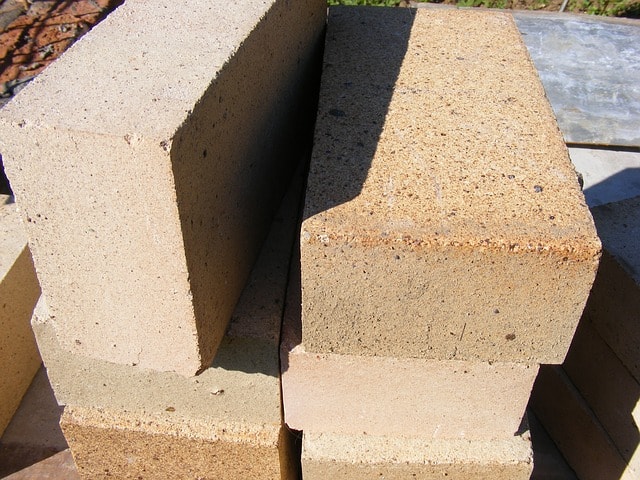If you own a fireplace you may have one built with bricks but you might be surprised to know that it isn’t made of the same bricks your house exterior is built with. Since a fireplace reaches very high temperatures, it requires bricks and mortar to hold the bricks in place that can withstand very high heat.
A fire brick is made of heat resistant materials like silica and alumina that is capable of withstanding temperatures from 1600oF to 3000oF. The bricks are designed to absorb but not transfer heat. Fire bricks tend to be white or yellowish in color and are used in fireplaces and fireboxes as well as kilns and ovens.
Having said that, modern fire bricks can be tinted and colored to offer a customized look so it’s important to look beyond the coloring to ensure you pick a genuine quality fire brick for your fireplace.
What is fire brick made of?
A fire brick is made of 73% silica and 23% sand comprising 96% of the total weight. The remaining 4% of weight is made of ferric oxide, titanium and other metallic oxides which give the brick its refractory (heat resistant) qualities. Fire bricks range from 9″ X 4.5″ X 2.5″ to 9″ X 2.75″ X 2.25″ in size.
A regular clay brick you’d find in a home exterior or other building is made predominantly of silica (sand) and alumina (clay) comprising about 70% – 90% by weight. A clay brick also contains lime, iron oxide and magnesia. These bricks are designed to withstand the elements and be durable and reliable for building purposes but are not refractory to the level of fire bricks because that is not their purpose.
Purpose of a fire brick

While a regular clay brick will begin to decompose at 1200o F, some fire bricks can withstand temperatures up to 3000o F. Fire bricks are sold as low-grade, medium-grade and high-grade depending on the fire clay used and thus can withstand different maximum temperatures ranges.
The purpose of a fire brick is to be used in a setting where very high temperatures are the norm. This is why you see fire bricks commonly used in fireplaces, fireboxes, furnaces and kilns among other uses. They can also be used to line chimneys and wood-fired ovens.
Because fire bricks conduct rather than transfer heat, they are additionally helpful in ovens – a pizza oven for example – as they will heat the oven quicker than clay brick to the required temperature.
How much does a fire brick cost?
You can buy fire bricks at retail and online for $2.50 – $6 per brick for standard usage. It’s not uncommon to find fire bricks suitable for home use starting at around $2.50 per brick at masonry supply stores and even at Lowe’s and Home Depot. Some stores will sell fire bricks individually but other products are sold in 6 – 12 brick packages.
More expensive specialty high alumina fire bricks cost around $40 that could be used in a Sulphur Recovery Unit (SRU).

What type of mortar is used for fire brick?
Do you need special mortar for fireplaces or is it the same as what is used for regular masonry work? Bricks require a fastening substance to hold them in place and to seal the gaps between them. This substance is called mortar and is the whitish gray colored material used between bricks on the exterior of your home for example. But for a fire brick, a special heat resistant mortar is used to match the heat resistant fire brick themselves.
Refractory cement or refractory mortar is used between fire bricks to hold and secure them in place and withstand the high temperatures that a fireplace experiences. Instead of using regular masonry mortar which can fail over time, refractory cement is designed using high alumina cement or calcium aluminate cement to produce its refractory and heat resistant properties.
A typical refractory cement is comprised of about 65% of refractory clay, about 15% ball clay and about 20% calcium aluminate cement each by weight.
Who to contact for fire brick work
Typically professional fire brick work is handled by a mason. Look for a professional masonry or tuckpointing company that can either install a new fireplace or repair an existing one with fire brick. It’s important to get this sort of repair work done right away when you notice damage due to the high temperatures and potential safety concerns.
Given the safety and health issues that arise from fireplaces and fire bricks, it’s best to leave this work in the hands of a professional. The last thing you want to do is handle the work yourself incorrectly and experience a fire that causes damage within the home or results in an insurance claim being denied if the problem is blamed on your workmanship.


